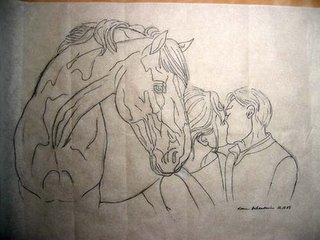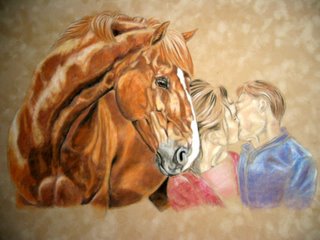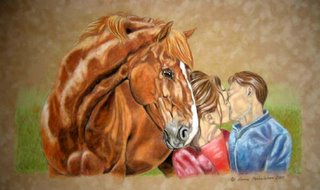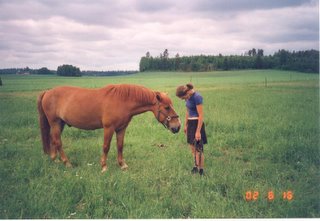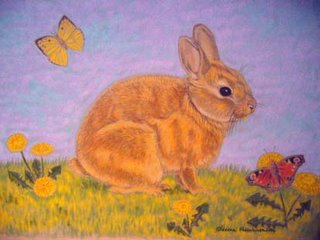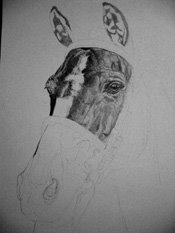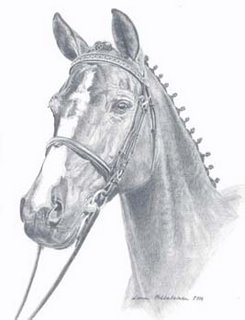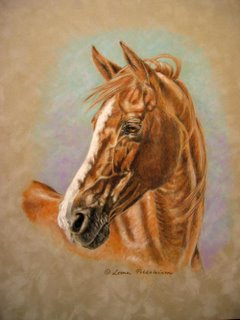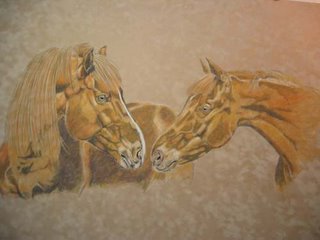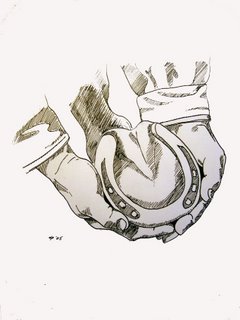
Here is an article about the Arabian horse. I found this on Wikipedia and edited it a bit. To illustrate it I put here a pastel painting I made of a straight Egyptian stallion Shy Gayfeen +++ - you´ll find him on his website
www.shygayfeen.comThe Arabian horseThe Arabian horse first appeared in the Arabian
Peninsula at least 2,500 years B.C.E. They were
carefully bred to maintain desirable features (e.g.
stamina, soundness, strength, and beauty), and are
therefore one of the oldest, if not the oldest breeds
in the world (this has been contested with the Barb
and the Akhal Teke.)
Early history
According to the Bedouins, God created the Arabian horse from the South Wind, saying
"I call you Horse; I make you Arabian and I give you the chestnut color of the ant; I have hung happiness from the forelock which hangs between your eyes; you shall be the Lord of the other animals. Men shall follow you wherever you go; you shall be as good for flight as for pursuit; riches shall be on your back and fortune shall come through your meditation".
The nomadic Bedouins are the first known to have tamed these fiery horses. The tribes were extremely protective of the purity of their stock, and many sheiks could recite the ancestry of their animals from memory. These forerunners of today's Arabian were bred for stamina and survival in the desert conditions, as well as the speed, courage, and loyalty needed for the constant battles between tribes. The Bedouins gained the reputation for breeding the finest
horses, and many horses were traded. The Arabian horse was so prized that in battle, when horses were captured, the parties would come together and share the bloodlines of the horses taken.
There are five strains or families in the Arabian breed. These include: Saqlawi, Dahman, Kuhaylan, Hadban, and Mu'niqi. While it is not commonly used in breeding today, it does hold significant historical value. A strain refers to a group of horses with common ancestors as well as physical characteristics. Since the background of every horse was passed down orally, it helped the bedouins to make breeding decisions.
One version of the story is that after a long trek through the desert a tribe of bedouin released their mares to run to a nearby watering hole to quench their thirst. But as a test of their loyalty, the bedouin called them back to their masters, and of all the many mares only five returned. These five became the five foundation mares of the Arabian breed.
The Continuing InfluenceBy 711 the Arabian horse had spread to Spain when it was conquered by the Arabs. Most of their mounts were Turkish or Barb, but a few were Arabian. From these horses developed the Andalusian (which were taken to the new world and helped develop many of the breeds in the Americas today). Meanwhile, European horses were infused with Arabian blood when the knights came down to Palestine for the Crusades and later returned home with the horses.
In the 15th century, firearms were developed. The slow-moving war horses of Europe were obsolete, and the faster Arabian horses were used to develop the quick, agile cavalry horses which would be on the European battlefields into the 20th century.
Arabians had also been brought to the Ottoman empire, where the studs used the horses for racing. They were then introduced into European racing. The Darley Arabian, one of three foundation stallions of the modern Thoroughbred breed was brought to England in 1703 (the other two being the Byerley Turk and the Godolphin).
The royalty of Europe took an interest in the Arabian, and established royal studs. One such stud, probably the most famous, was the Crabbet Stud in Crabbet Park, England. Wilfrid Scawen Blunt and his wife, Lady Anne Blunt, began importing the breed in 1878. For nearly a century, the family bred the Arabian and conserved the breed's purity, later exporting the horses for use as foundation stock in Poland, Russia, Australia, and North and South America. The stud was closed in 1971.
In 1893, the World Fair in Chicago exhibited 45 Arabians. The breed's interest in the United States grew, and the United States stud book was established in 1908, with a total of 71 animals. By 1994, the number had reached half a million. There are now more Arabians registered in North America than in the rest of the world put together.
In the 1980s, the Arabian's popularity soared. Many people were captivated by the beautiful breed. Celebrities bought the horses. Prices soared, especially in the United States, with some horses going for $150,000 to $1 million each. This created new breeders, and many importations of Arabians, helping create what the breed is today. When
tax laws for horses were changed, the market collapsed, and the amount of horses were worth much less.
Today, there are many different types of Arabian, ranging from Polish, Spanish, Crabbet, Russian to Egyptain and Domestic (Usually a mix of bloodlines). Polish and Crabbet are known for the substance and athleticism, Spanish for their beauty and athleticism, Russian for their height and substance, Egyptain for their ultimate Arabian type, and Domestic for their
combination of all the wonderful traits of each bloodline. Crabbet Arabians can even be narrowed down farther into Davenport and Kellogg. For each Arabian their individual backgrounds and pedigree will help you understand the horse you see today.
Whatever the type, the breed is currently being bred both for the Arabian type and athleticism. At breed shows, the Arabian constantly displays its versatility. They are also growing in demand for dressage, where their natural self-carriage and movement is attractive. However, they truly excell in endurance and long-distance riding, where the horse would complete up to 100 miles in a day. They hold the world records for the sport, and are not only usually the first to finish, but also win the "best conditioned" award as well. Arabians often compete in Open Shows, competing against other breeds in different disciplines.
Breed characteristics
The Arabian is one of the most easily recognizable breeds in the world. They have fine wedge-shaped heads, with large eyes, small muzzles and their famous "dished" profile (the nose is concave). Arabians also tend to have very high tail carriage. They have large nostrils and strong lungs, which contributes to their powers of endurance. They have an arched neck with a fine, clean throat, delicate and clean legs, and a fine, silky coat. Most Arabians have the free flowing, well coordinated, reaching, fluid gaits. They can glide across the ground with no effort. They had natural self-carriage. With correct training, they can have collection and extension at every gait. They typically have natural impulsion and bend. Their gaits are regular and balanced. Their naturally arched necks allow for more head movement in all directions. They can obtain different types of frames depending on the desired discipline. Their shorter backs able them to push their hind end up and under them for better movement and suppleness. Sensitivity and sociability allows them to be trained more easily. Natural beauty gives them presence in the show ring. Arabians are very sound, they have strong bones, wide, strong feet, and good hoof walls. Their bone size is compatible to their body size, making them very sturdy horses.
The coat color of Arabians is diverse, with chestnut and grey as the dominant color, followed by bay and black. Black Arabians are rare, mainly because they were bred in the desert, where a black or dark coat would absorb heat and therefore be detrimental to the horse. However, many breeders are breeding specifically for black Arabians, so the color is not as uncommon as it used to be. Purebred Arabians can display the pattern sabino. Sabino can be minimally expressed as a small white spot on the body, or as high jagged edged socks, and at its maximum the horse
can be entirely white with small flecks that appear to be, but are not, roan. This color allows a purebred Arabian to be double-registered with Pinto Breed organizations. Arabians do not express the dilute gene which produces palomino, cremello, and other dilute colors. Many half-Arabians are bred to produce pinto and dilute colors. The Arabian has a compact body with
a short back, partly due to the 5 lumbar vertebrae instead of the normal horses' 6, and usually stands between 14.0 and 15.1 hands. Arabians are always referred to as horses, not ponies, whatever their height. The breed is also known for its intelligence, versatility, and very affectionate nature.
Due to the Arabian's notable traits, there have been many Arabians and Half Arabian approved by Warmblood registries, such as the American Warmblood Society, Oldenburg, and Trakehner Associations.
The Arabian TodayBecause of the genetic purity of the Arabian horse, it is often used as a refining influence on other breeds, and has played a significant part in the evolution of almost every recognized breed, including Thoroughbreds, Percherons, Welsh Ponies, American Quarter Horses, Morgans, Saddlebreds, and all of the warmblood breeds. The Arabian has influenced more breeds than any other horse.
The UC Davis Book of Horses, p. 20, compares Arabians with various other breeds and lists this
breed's temperament as "highly strung", though their individual temperament will depend on how the horse is raised and trained. It lists the breed's categories as "speed, endurance, intelligence, courage, and gentleness."
Over the course of the breed's history they have for centuries lived in close association
with human families. They are emotionally very much attuned to both their herd members and their human families. For that reason they tend to be protective of humans and suitable as companions for children. At the same time, they were in the beginning joined symbiotically with humans in a hostile environment that occasionally included armed combat and other sudden dangers. They are therefore adept at making sudden course corrections at high speed, which can
pose a challenge even to fairly accomplished riders. Their athleticism also makes them a very versatile breed, and they are capable of competing in many fields, including Dressage, saddleseat, Western Pleasure, Cutting, Reining, Endurance riding, Hunter/Jumper, Eventing, Combined Training, Barrel Racing, and many others. They also make very reliable trail riding buddies, for those who are not interested in showing. They dominate the endurance world because of their incredible stamina, which far exceeds that of many other breeds. There is also Arabian racing, which is separate from the more popular Thoroughbred racing.
Arabian as a Sports HorseTheir use in the "sport horse" disciplines, such as dressage, hunter/jumper, eventing, and combined training, has finally become more widely recognized, though they have been successfully competing in these events for a very long time. The American Arabian Horse Association has now been hosting an Arabian and Half Arabian Sport Horse Nationals since 2003. In the 2005 Arabian and Half Arabian Sport Horse National there were 1906 entries, competing in Working Hunter, Jumper, Sport Horse Under Saddle, Sport Horse In Hand, Dressage, and Carriage Driving.
· Page Version ID: 30796750
"Arabian horse." Wikipedia, The Free Encyclopedia.
10 Dec 2005, 05:33 UTC. 11 Dec 2005, 09:24 <
http://en.wikipedia.org/w/index.php?title=Arabian_horse&oldid=30796750>.
***
Tässä on artikkeli arabialaisesta täysverihevosesta, jonka löysin Wikipediasta ja jota hieman editoin. (Käänsin tekstin itse). Kuvitukseksi liitän tähän kuvan pastellimaalauksesta, jonka tein egyptinarabiori Shy Gayfeenistä. Löydät oriin sen kotisivuilta
www.shygayfeen.com.
Arabialainen täysverinenArabihevoset ilmestyivät Arabian niemimaalle noin 2500 eKr. Niitä jalostettiin huolellisesti, jotta halutut ominaisuudet säilyivät (esim. sisukkuus, järkevyys, voima ja kauneus) ja rotu on yksi vanhimmista, ellei jopa vanhin hevosrotu maailmassa (haastajina barb/berberihevonen ja akhal teke).
Varhaishistoria
Beduiinien mukaan Jumala loi arabialaisen hevosen etelätuulesta sanoen:
"Kutsun sinua hevoseksi; teen sinusta arabialaisen ja annan sinulle rautiaan värin kuin muurahaisella; olen ripustanut onnen silmiesi välissä olevaan otsaharjaan; sinä olet muitten eläinten herra. Miehet seuraavat sinua minne menetkin; olet yhtä hyvä niin pakoon kuin takaa-ajoonkin; rikkaudet ovat selässäsi ja hyvä onni tulee mielesi kautta"
(tämä oli hiukan vaikea käännettävä, koska "fortune" voi olla sekä omaisuus että hyvä onni ja "meditation"-sanaa en oikein halunnut kääntää meditoimiseksikaan.)
Paimentolaisbeduiinit kesyttivät nämä tuliset hevoset ensimmäisinä. Heimot olivat äärimmäisen tarkkoja hevostensa rotupuhtaudesta, ja monet sheikit pystyivät luettelemaan eläintensä sukujuuret muistista. Näitä nykyarabihevosen edeltäjiä kasvatettiin sisukkaiksi ja aavikko-oloihin sopiviksi, mutta myös nopeiksi, rohkeiksi ja uskollisiksi jatkuvien heimotaisteluitten takia. Beduiinit saivat maineen hienoimpien hevosten kasvattajina ja hevosista käytiin vaihtokauppaa. Arabihevosta arvostettiin taistelussa niin paljon, että kun hevosia saatiin kiinni, osapuolet kokoontuivat jakamaan kiinnisaatujen hevosten sukulinjat.
Arabialaisen hevosrotuun kuuluu viisi sukulinjaa. Nämä ovat Saqlawi, Dahman, Kuhaylan, Hadban ja Mu´niqi. Vaikka näitä ei käytetä yleisesti enää nykypäivän jalostustyössä, on sukulinjojen historiallinen merkitys suuri. Sukulinja viittaa ryhmään hevosia, joilla on yhteiset esi-isät ja joilla on myös yhteisiä fyysisiä ominaisuuksia. Jokaisen hevosen tausta kerrottiin eteenpäin suullisesti ja tämä auttoi beduiineja tekemään jalostuspäätöksiä.
Yksi versio sukulinjojen tarinasta kertoo miten pitkän aavikkomatkan jälkeen beduiiniheimo päästi tammansa irti, jotta ne voisivat juosta läheiselle juottopaikalle tyydyttämään janonsa. Mutta testatakseen näiden uskollisuutta beduiinit kutsuivat hevoset takaisin isäntiensä luokse. Vain viisi tammaa palasi. Näistä viidestä tammasta tuli arabialaisen hevosrodun kantatammat.
Vaikutus leviääVuoteen 711 mennessä arabihevonen oli levinnyt Espanjaan arabivalloittajien mukana. Suurin osa heidän ratsuistaan oli turkkilaisia hevosia tai berberihevosia, mutta muutama oli arabialainen. Valloittajien hevosista kehittyivät andalusialainen rotu (jota vietiin uuteen maailmaan, jossa se auttoivat kehittämään monia nykyisen Amerikan hevosroduista). Samaan aikaan eurooppalaiset hevoset saivat arabialaisesta hevosesta vaikutteita, kun ritarit saapuivat Palestiinaan ristiretkille ja myöhemmin palasivat kotiinsa hevosineen.
1400-luvulla kehitettiin ampuma-aseet. Euroopan hitaat sotahevoset olivat hyödyttömiä, ja nopeampia arabialaisia hevosia käytettiin, jotta saatiin kehitettyä nopea, ketterä ratsuväen hevonen, joka tulisi pysymään Euroopan taistelukentillä 1900-luvulle asti.
Arabialaisia hevosia oli tuotu myös ottomaanien valtakuntaan, jossa siittolat käyttivät hevosia kilparatsuina. Nämä hevoset vaikuttivat sittemmin Euroopan laukkakilpailuissa. Darley Arabian, yksi kolmesta nykyisen englannin täysverihevosen kantaoriista, tuotiin Englantiin vuonna 1703 (kaksi muuta kantaoritta olivat Byerley Turk ja The Godolphin).
Euroopan kuninkaalliset kiinnostuivat arabialaisesta hevosesta ja perustivat kuninkaallisia siittoloita. Yksi sellainen siittola, kenties kaikkein tunnetuin, oli Crabbetin siittola Crabbet Parkissa Englannissa. Wilfrid Scawen Blunt ja hänen vaimonsa lady Anne Blunt, alkoivat tuoda rotua maahan 1878. Lähes vuosisadan ajan perhe jalosti arabialaisia hevosia ja säilytti rodun puhtauden. Myöhemmin he myivät hevosia kantakirjahevosiksi Puolaan, Venäjälle, Australiaan ja Pohjois- ja Etelä-Amerikkaan. Siittola suljettiin vuonna 1971.
Vuonna 1893 Chicagon maailmannäyttelyssä esiteltiin 45 arabialaista hevosta. Kiinnostus rotuun kasvoi ja Yhdysvaltojen kantakirja perustettiin 1908. Siihen kuului 71 eläintä. 1994 mennessä hevosten määrä oli noussut puoleen miljoonaan. Nykyään Pohjois-Amerikassa on rekisteröity enemmän arabialaisia hevosia kuin muualla maailmassa yhteensä.
1980-luvulla arabialaisen hevosen suosio nousi huimasti. Monet joutuivat tämän kauniin rodun lumoihin. Kuuluisat ihmiset ostivat arabihevosia. Hinnat nousivat pilviin, etenkin USAssa, jossa joistain hevosista maksettiin 150.000$ - 1.000.000$.
Tästä syystä ilmestyi paljon uusia arabihevosten kasvattajia ja paljon arabialaisia hevosia tuotiin maahan. Tämä auttoi luomaan rodun sellaiseksi kuin se on nyt. Kun hevosia koskevia verolakeja muutettiin, markkinat romahtivat ja hevosten hinnat samaten.
Nykypäivänä arabialaista hevosta on monta eri tyyppiä: puolalainen, espanjalainen, crabbet, venäläinen, egyptiläinen ja näitten verilinjojen sekoitus. Puolalainen ja crabbetin arabihevonen tunnetaan jykevämpänä ja atleettisempana, espanjalainen kauniina ja atleettisena, venäläinen korkeana ja jykevänä, egyptiläinen äärimmäisestä arabialalaistyyppisyydestään ja näitten sekoitukset siitä, miten eri verilinjojen upeat ominaisuudet ovat sekoittuneet. Crabbetin arabialaiset hevoset voidaan tyypittää Davenport- ja Kellogg-tyyppiin. Jokaisen arabialaisen hevosen tausta ja sukulinjat auttavat ymmärtämään tämän päivän hevosta.
Mikä tahansa hevosen tyyppi onkaan, rotua jalostetaan sekä arabialaisen tyypin että atleettisuuden vaatimuksilla. Rotunäytelyissä arabialainen hevonen jatkuvasti todistaa monikäyttöisyydestään. Niitä halutaan yhä enemmän kouluratsastukseen, jossa niiden luontainen ryhti ja liike ovat viehättäviä. Kuitenkin ne ovat parhaimmillaan kestävyys- ja pitkänmatkan ratsastuksessa, jossa hevonen kulkee jopa 100 mailin matkan päivässä. Arabialaiset hevoset pitävät hallussaan lajin maailmanennätyksiä, eivätkä ole tavallisesti vain ensimmäisenä maalissa, vaan voittavat paraskuntoisten palkinnotkin. Arabialaiset kilpailevat eri lajeissa usein avoimissa luokissa muita hevosrotuja vastaan.
RotuominaisuudetArabialainen hevonen on yksi helpoimmin tunnistettavista roduista maailmassa. Niillä on hieno, kiilamainen pää, isot silmät, pieni turpa ja kuuluisa kovera profiili. Arabialaisella on myös hyvin korkea hännän asento. Sillä on suuret sieraimet ja voimakkaat keuhkot, joiden ansiosta se on hyvin kestävä. Sillä on kaareva kaula, hieno puhdas kurkun alue, sirot ja puhdasmuotoiset jalat ja hieno, silkkinen karva. Yleensä arabialaisella hevosella on vapaasti liukuva, hyvin koordinoitu, pitkä ja sulava askel. Se pystyy liukumaan eteenpäin ponnistelematta. Se kantaa itsensä kauniisti luonnostaan. Oikealla koulutuksella se voi koota tai pidentää askeltaan joka askellajissa. Arabialainen hevonen on tyypillisesti luonnostaan hyvin taipuisa. Askellajit ovat säännölliset ja tasapainoiset. Arabialaisen luonnostaan kaareva kaula mahdollistaa pään liikkeen joka suuntaan. Se voi asettua eri lajien vaatimaan muotoon. Sen lyhempi selkä mahdollistaa takaosan liikkuvuuden sekä ylös että alle paremman liikkeen ja notkeuden saavuttamiseksi. Herkkyys ja sosiaalisuus mahdollistaa sen helpomman kouluttamisen. Luontainen kauneus tuo sen hienosti esille näyttelyissä. Arabialainen on hyvin terve, sillä on voimakkaat luut, leveällä olevat voimakkaat jalat ja hyvät kaviot. Sen luusto on sopusuhtainen kehon kokoon nähden ja tekee arabialaisesta hyvin vankan hevosen.
Arabialaisen karvan väri vaihtelee, raudikko ja harmaa ovat yleisimmät värit, seuraavina ruunikko ja musta. Mustat arabialaiset ovat harvinaisia, lähinnä siksi että hevosia jalostettiin aavikko-olosuhteissa, joissa musta tai tumma karva imi lämpöä ja oli siksi haitallinen hevoselle. Kuitenkin monet jalostajat erikoistuvat mustiin arabihevosiin, joten väri ei enää ole niin harvinainen kuin ennen. Puhdasverinen arabialainen voi olla sabino-kuvioinen. Kuvio voi esiintyä minimaalisesti valkoisena läikkänä kehossa, tai korkeina rosoreunaisina sukkina ja kuvion maksimimuodossa hevonen voi olla kokonaan valkoinen ja siinä voi olla pieniä läikkiä, jotka vaikuttavat päistärikkökarvoilta mutta eivät ole. Tämä värikuvio mahdollistaa puhdasverisen arabialaishevosen rekisteröinnin myös pintovärirekisteriin. Arabihevosella ei ole väriä haalistavaa geeniä, joka saa aikaan palominon, cremellon ja muut "laimeat" värit. Paljon puoliarabeja kasvatetaan, jotta saataisiin aikaan pintokuvio ja ”laimennettuja” värejä.
Arabihevosella on tiivis, kompakti ruumis, ja sillä on lyhyt selkä, osittain siksi että sillä on vain viisi lannenikamaa tavallisten hevosten kuuden sijaan. Yleensä arabihevosen säkäkorkeus on 147 - 155 cm. Arabialaisesta puhutaan aina hevosena, ei ponina, oli sen säkäkorkeus mikä hyvänsä. Rotu tunnetaan myös älykkyydestään, monipuolisuudestaan ja hellästä luonteestaan.
Arabialaisen tärkeistä ominaisuuksista johtuen monia arabi- ja puoliarabihevosia on hyväksytty lämminverihevosten rekistereihin, kuten esimerkiksi Amerikan lämminveriyhdistykseen, Oldenburg- ja Trakehneryhdistyksiin.
Arabialainen hevonen tänäänArabialaisen hevosen geneettisen puhtauden vuoksi sitä käytetään usein muitten rotujen jalostamisessa ja se on näytellyt merkittävää osaa miltei jokaisen tunnustetun rodun kehityksessä, mukaan lukien englannin täysverinen, percheron, walesin ponit, Amerikan quarter-hevonen, morganhevonen, saddlebred ja kaikki muut lämminverirodut. Arabialainen hevonen on vaikuttanut useampaan rotuun kuin mikään muu hevosrotu.
UC Davis "Book of Horses" -kirja, s.20 vertaa arabialaista hevosta eri hevosrotuihin ja kuvailee arabihevosta herkkähermoiseksi, vaikka kunkin hevosen yksilöllinen tempperamentti riippuu siitä, miten hevonen on kasvatettu ja koulutettu. Kirja kuvailee rodun määritelmiksi "nopeuden, kestävyyden, älykkyyden, rohkeuden ja lempeyden." Rodun historian kuluessa arabialaiset hevoset ovat eläneet vuosisatoja läheisessä yhteydessä ihmisperheisiin. Ne ovat tunneperäisesti hyvin sopeutuneita sekä oman laumansa jäseniin että ihmisperheisiinsä. Tästä syystä ne ovat suojelevia ihmisiä kohtaan ja sopivia kumppaneita lapsille. Samanaikaisesti ne olivat aluksi symbioottisessa suhteessa ihmisten kanssa vihamielisessä ympäristössä, jossa toisinaan jouduttiin aseelliseen taisteluun tai muihin yllättäviin vaaroihin. Tästä syystä ne ovat kykeneviä yhtäkkisiin suunnanmuutoksiin suurissa nopeuksissa, mikä voi osoittautua haasteeksi jopa melko kokeneellekin ratsastajalle. Niiden atleettisuus tekee rodusta hyvin monikäyttöisen ja ne kykenevät kilpailemaan monessa lajissa, mukaan lukien kouluratsastus, saddleseat-ratsastus (satula on taaempana, ratsastaja istuu pystymmässä, hevonen kantaa päänsä pystymmässä ja hevosen etupää on keveämpi ja liikkeet korkeampia - kääntäjän oma kommentti), lännenratsastus eri muodoissaan, kestävyysratsastus, hunter/hyppyluokat, tynnyriratsastus ja monet muut ratsastuksen muodot. Ne ovat myös hyvin luotettavia vaellusratsastuksessa, jos ratsastaja ei ole kiinnostunut näytöslajeista. Ne dominoivat kestävyysratsastusta uskomattoman sisunsa ansiosta, joka ylittää monen muun rodun sisukkuuden. Arabialaisille hevosille järjestetään myös laukkakilpailuja - kyseessä on eri kilpailulaji kuin suositummat englannin täysiveristen laukkakilpailut.
Arabialainen urheiluhevosena
Arabialaisten hevosten käyttö "urheiluhevosena" kouluratsastuksessa, hunter/hyppyluokissa ja kenttäkilpailuissa on vihdoin saanut laajempaa arvostusta, vaikka ne ovat kilpailleet menestyksellä näissä lajeissa jo hyvin pitkään. Amerikan arabihevosyhdistys on järjestänyt arabi- ja puoliarabiurheiluhevosten kansallisia kilpailuja vuodesta 2003. Vuoden 2005 tapahtumassa oli 1906 ilmoittautunutta.
· Page Version ID: 30796750
"Arabian horse." Wikipedia, The Free Encyclopedia.
10 Dec 2005, 05:33 UTC. 11 Dec 2005, 09:24 <
http://en.wikipedia.org/w/index.php?title=Arabian_horse&oldid=30796750>.
